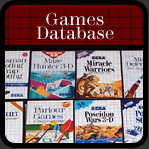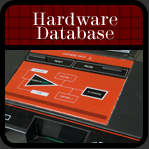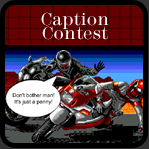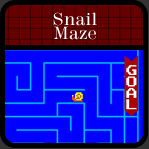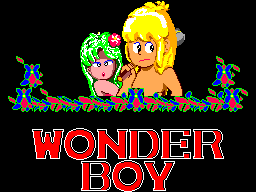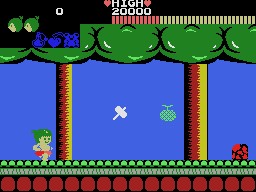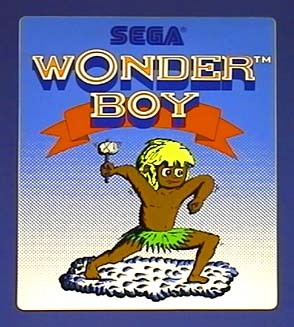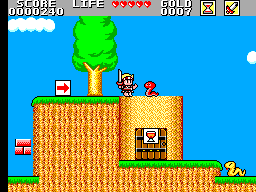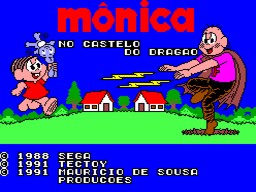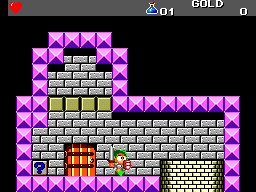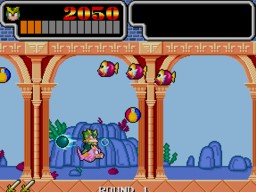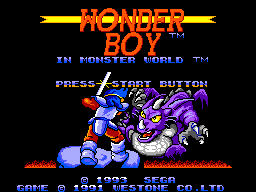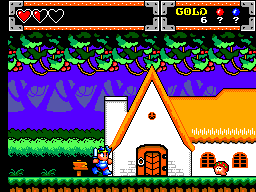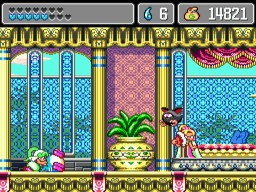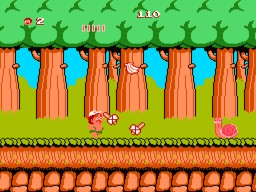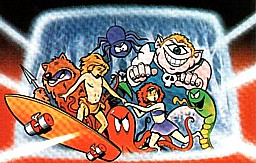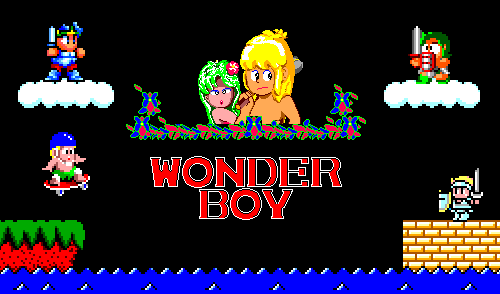 |
|
Character Information :
|
|||||||||||||||||||||
|
Well what did this classic chap look like? As seen below from the original arcade cabinet, his first appearance was simple. He was given tawny, yellow hair, his categoristic stone hatchet (which is picked up in the game but became synonymous with his early image) and a small loin cloth made from leaves. Technically, you could include the skateboard as part of his look, but this too was not utilized until located in the game and wasn't as integral as the hatchet. His design and appearance would change for the final three Master System titles, though continuing with the same basic format you see below. We suppose you could consider the man under the armor the same loinclothed tot that started it all, but it did change eventually. After the first game he always appears in a suit of armor with a sword and then later with blue hair and a slightly different apparance. Before talking about this aspect, however, let's start from his first game and move on from there...
Wonder Boy was originally the idea of a company called Escape, who Sega worked with to release the arcade title in 1986. Eventually it was ported to the Master System and a variety of other systems at the time only one year after he first hit the coin-op market. The concept was simple, but original even for its time. The programmers conceived of an islander named Tom-Tom who had to travel around an island, fight various creatures and take on a number of bosses in a huge amount of levels to save his girlfriend Tanya. The story basically runs that Tom-Tom and Tanya are sitting around until the woodland King (just called "King" in the game proper) kidnaps her. Then, since Tom-Tom isn't exactly sure where she is, he begins his adventures of inspecting every inch of the island until he finds her. With forty levels in all, tons of enemies, a variety of landscapes and obstacles, hordes of secrets, a hidden level only accessible by carefully collecting special dolls (some hidden) and a unique life meter feature involving the collection of food to keep it from decreasing so the player constantly moves forward, Wonder Boy was a groundbreaking title. After the success of his port onto the Master System, Sega then decided to use Tom-Tom in a different format, one that stuck until he eventually was swept away by some issues we'll get to later.
In 1988 Tom-Tom had his name altered as well as the entire world he was previously adventuring in. First he was on an island that seemed reminiscent of early "island films," complete with occasional totems and the like. For his second adventure, Wonder Boy in Monster Land, things were different. Starting from the story of the first game, players learn that Tom-Tom is the nickname of Bock Lee Temjin, who lives in a world called Wonder Land. Eleven years after he defeated the evil King a dragon appeared and took over Temjin's world with the help of his "evil, monstrous henchmen." This once serene land turned evil is now called Monster Land, and Bock, by now a teenager, sets out to defeat the monsters and destroy the Meka dragon. Now he was given twelve different locations to travel through as well as new weapons. Gone is the need to collect food, though you are still on a form of timer, and now Wonder Boy can use magic weapons, purchase armor and even cast spells! The game was made closer to an RPG in some respects, for example you need to locate secret keys to access boss levels and continue towards the Meka dragon. Though not necessarily a difficult game, the lack of a continue or password feature made it much harder than its predecessor. The title was an instant hit for Sega, and was ported onto a number of systems such as the Amiga. This was also his first 16-Bit appearance under the title of Super Wonder Boy in Monster Land.
With the success of Monster Land, Sega went further with Wonder Boy and developed his image from the second game. In arcades in 1988 they released Wonder Boy III: Monster Lair, even before Monster Land was ported to the Master System. Lair was later released on the Genesis/MegaDrive and TurboGrafx-16, but bears hardly any resemblance to what is widely considered one of the greatest games ever released for the Master System and easily the best in the series, Wonder Boy III: The Dragon's Trap. Released in 1989 to enthusiastic fans, it further develops the story of Monster Land. Temjin, now just called Wonder Boy, was cursed by the Meka dragon after he defeated him; turned into a Lizard-Man! To save himself he needs to locate the Salamander Cross hidden in Monster Land. Unlike the previous titles, the first being completely linear and the second with some nonlinear elements, Wonder Boy can now investigate any part of the world he wants to as long as he has the proper items to do it. Even more involving is the fact that as Wonder Boy progresses, he is cursed by additional bosses and is given the ability to turn into other creatures.
His popularity then solidified and with a solid series under his belt, Wonder Boy was taken a step further with the release of Wonder Boy in Monster World in 1993 for the Master System and in 1994 for the Genesis/Megadrive. The game was later ported and altered to consoles such as the PC Engine in Japan and as another Mônica game for the Megadrive in Brazil, but neither of these are important for our purposes. For SMS fans, Wonder Boy returned in what is usually looked at as the second best title in the series. Monster World was unfortunately only released in Europe during this time, and remains not all that common as far as rarity is concerned. In his final Master System appearance, Wonder Boy is called upon by the people of Monster World to save them from the creatures who have plagued their land and to rescue Princess Sheila, who disappeared after she began to search for a hero to save her kingdom. Wonder Boy, now called Shiron, is of course this very hero.
Wonder Boy's final appearance, or more properly the final appearance of a game included in the series, only occured for the Megadrive in Japan. As usual, some of the best ports were never released elsewhere, and the final installment, which is techincally part of the Monster World series and involves little to do with Wonder Boy, is called Monster World IV. Since it has hardly anything involving the original series save some connections in storyline, we're not going to go much further, suffice to say that in this title you play a girl named Asha who has to save her desert people from impending disaster. Designed with a middle-eastern feel to it, most fans of the original series may be disappointed to discover this title has little to do with Wonder Boy, good though it may be. If one is to consider it part of the canon, many fans find this title to be the best of all, but we here at Sega8Bit find the issue moot since Monster World IV features almost nothing to do with the original character and thus has nothing to do with his history. In fact, if anything, it has to do with his demise.
The fact is that in spite of his workability, Wonder Boy has ceased to reappear in the modern world of video games. It's difficult to say what Sega may do with Wonder Boy in the current age where the focus is more on violence. Westone, who was originally the company Escape we mentioned earlier, is now nonexistent and Sega itself has been reduced to making games for other companies since it decided to leave the console scene. Wonder Boy, unfortunately, seems to have slipped to the side in the history of video gaming in the process and few people save those interested in the Master System are even aware of him. This is likely due to the confusing jumble of releases in which he appeared (see links below for a chronological list of titles because I'm sure you're confused), the plethora of systems he appeared on, hacking ala' Korea as Adventure Kid on 4 Pak All Action and changes in themes in video game history. Monster World IV put the character nearly to rest due to a complete lack of inclusion, and may have unfortunately pushed his importance to nothing more than a footnote. Two years ago, however, it should be known that Sega released a version of Wonder Boy for cellphones, but it's doubtful this could potentially lead to a revival. | |||||||||||||||||||||
|
Character
- Gameography :
|
|
| Master System Titles: Genesis/Megadrive Appearances:
Game Gear Appearances:
|
|
Images of Wonder Boy :
|
|||||||||
|
|||||||||
|
Related Links :
|
|
| |


